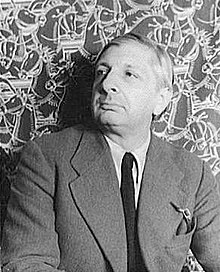Giorgio de Chirico | |
|---|---|
 Photograph of Chirico by Carl Van Vechten, 1936 | |
| Born | Giuseppe Maria Alberto Giorgio de Chirico 10 July 1888 Volos, Greece |
| Died | 20 November 1978 (aged 90) Rome, Italy |
| Resting place | Church of San Francesco a Ripa, Rome 41°53′06″N 12°28′23″E / 41.885127°N 12.473186°E |
| Education | |
| Known for |
|
| Movement | |
| Spouses | |
| Signature | |
 | |

Giuseppe Maria Alberto Giorgio de Chirico (/ˈkɪrɪkoʊ/ KIRR-ik-oh; Italian: [ˈdʒordʒo de ˈkiːriko]; 10 July 1888 – 20 November 1978) was an Italian artist and writer born in Greece.[2][3] In the years before World War I, he founded the scuola metafisica art movement, which profoundly influenced the surrealists. His best-known works often feature Roman arcades, long shadows, mannequins, trains, and illogical perspective. His imagery reflects his affinity for the philosophy of Arthur Schopenhauer and of Friedrich Nietzsche, and for the mythology of his birthplace.
After 1919, he became a critic of modern art, studied traditional painting techniques, and later worked in a neoclassical or neo-Baroque style, while frequently revisiting the metaphysical themes of his earlier work. In 2018 it was suggested that de Chirico may have suffered from Alice in Wonderland syndrome.
- ^ a b "Biography". Fondazione Giorgio e Isa de Chirico.
- ^ Union List of Artist Names Online, retrieved 15 February 2019.
- ^ Rivosecchi, Valerio (1987). "De Chirico, Giorgio". Enciclopedia Italiana (in Italian). Retrieved 17 February 2019.